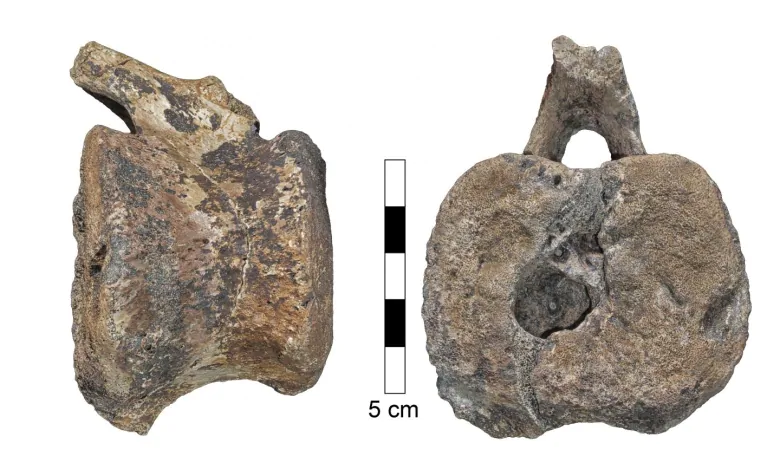Dinosaur found with signs of tumour-causing disease that afflicts humans today

Fossils from a hapless hadrosaur from Alberta show telltale signs of a disease that causes tumours in human children, showing the affliction has been around since at least the Age of Dinosaurs, a new study suggests.
Bones from the tail of a truck-sized duck-billed, plant-eating dinosaur that lived about 75 million years ago had some large, unusual holes in them that caught the eye of Darren Tanke of the Royal Tyrrell Museum in Drumheller, Alta.
In a new study published last week in the journal Scientific Reports, Tanke and collaborators in the U.S. and Israel propose that the holes were caused by tumours from Langerhans cell histiocytosis (LCH). The disease affects about one in 200,000 human children and, in rare cases, adults, according to the Histiocytosis Association of Canada.
The disease, which can be painful but usually isn’t fatal in humans, is caused by an overgrowth of immature white blood cells called Langerhans cells, which can accumulate into tumours in parts of the body such as the skin, bones, lymph nodes or liver.
There is some debate whether it is an immune dysfunction or a non-malignant cancer, and the cause is unknown, although it is not contagious and usually not inherited. In humans, aggressive cases are often treated with chemotherapy.
‘Pathological’ bones tell stories
Tanke, a technician at the museum, has been excavating fossils in Alberta’s Dinosaur Provincial Park for more than 40 years. He’s particularly interested in “pathological” bones showing injuries or diseases that can tell us more about how dinosaurs lived.
One day, he was out fossil hunting when he found a cluster of tail bones from hadrosaurs that roamed the coastal plains of Alberta during the Late Cretaceous.
Tail bones, especially those near the end of the tail, often show injuries — Tanke suggests that many may come from the huge animals, which roamed in herds, stepping on each other’s tails. He took a closer look at this particular cluster and noticed that some were broken through the middle to reveal deep, circular holes.
“It reminded me a lot of when you cut a block of Swiss cheese and encounter a new hole,” he said. “I had never seen anything like it before.”
Knowing he had found something very unusual, he sent some photos to Bruce Rothschild, a research associate with the Carnegie Museum and a professor of medicine at Indiana University, who has worked with him on other projects related to diseased and injured dinosaur bones.
Rothschild, who later visited and took a closer look, said there aren’t a lot of things that can create holes in bone, especially holes of this shape, which were smooth with little bulges or “outpockets” visible under a microscope. He had never seen anything like it before in dinosaurs — but he had in some human bones belonging to people with LCH.
“I’d never even heard of it,” Tanke recalled.
To confirm his hypothesis, Rothschild sent the fossils to Hila May, a researcher at Tel Aviv University, for micro-CT scanning. The researchers compared the results to holes in human bones with LCH, and found they shared very similar shapes.
But at least one expert has some doubts. Dr. James Whitlock is a pediatric oncologist at the Hospital For Sick Children in Toronto who has treated and researched LCH in children for over 30 years. He was not involved in the study.
Whitlock says in humans, the disease is diagnosed by looking at tissues under the microscope. He’s not sure a diagnosis can be made by looking at the holes left in the bone.
“As a health scientist, it’s not that convincing to me,” said Whitlock, who is also a director of the Histiocytosis Association of Canada.
That said, he hopes the study raises awareness of the rare disease and helps doctors diagnose it.

But how bad is LCH?
Whether the hadrosaur had LCH or not, the researchers don’t know is what impact the holes in its bones would have had on the animal.
In humans, sometimes LCH causes no symptoms. The disease is considered “low-risk” when it affects the bones, though it’s worse if it affects the spleen, liver or bone marrow.
The animal that had the holes in its tail bones was an adult about eight metres long and taller than a human, and looked like it had had the disease for some time, Tanke said.
But he added that hadrosaurs are “very tough” — he’s seen bones from individuals that have survived and healed from “pretty spectacular” injuries, including broken limbs and pelvises.
While this is the first dinosaur ever found with possible signs of LCH, it has been seen in other animals, including tigers and a tree shrew.
Rothschild, who has compared signs of disease in many animals, said many diseases, from gout to psoriatic arthritis, can affect a wide range of animals, and can look quite similar in all of them.
“We’re all God’s children,” he said. “It sounds like a funny way to phrase it, but we all have the same susceptibility.”





